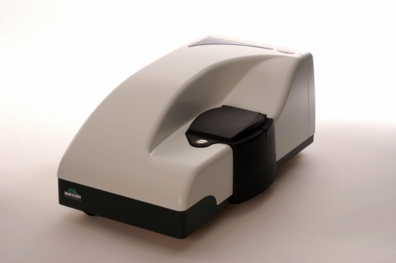Home > Press > New nanoparticle reference materials support development of novel applications
 |
Abstract:
The National Institute of Standards and Technology (NIST) has used the Zetasizer Nano particle characterization system from Malvern Instruments as part of the qualification and assessment process for its new gold nanoparticle reference materials. The three new reference materials, launched in January of this year, were developed in cooperation with the National Cancer Institute's Nanotechnology Characterization Laboratory (NCL). They will facilitate data consistency across pre-clinical biomedical research and accelerated development of methodologies and applications that rely on nanoscale measurements.
New nanoparticle reference materials support development of novel applications
Malvern, UK | Posted on August 28th, 2008Reference Materials (RM) are designed specifically to enable interlaboratory test comparisons. The previous lack of nanoparticle standards, used to verify the accuracy of measurements and ensure that data are robust, has made the advancement of new measurement methods that rely on nanoscale parameters difficult.
Nanotechnology holds the promise of increased speed and efficiency across many analytical systems. The nominal 10, 30 and 60 nanometre gold spheres are the first nanoscale standard references. They represent the advent of much needed standardization at this scale and, by enabling evaluation and qualification of methodologies and instrument performance, should expedite swifter development and approval of novel techniques and applications.
The new RMs were evaluated using six independent methods - atomic force microscopy (AFM), transmission electron microscopy (TEM), scanning electron microscopy (SEM), differential mobility analysis (DMA), dynamic light scattering (DLS - Zetasizer Nano), and small-angle X-ray scattering (SAXS). While NIST neither recommends nor endorses instrumentation, Malvern is pleased to note that the Zetasizer Nano and 3000HS were used in the assessment processes.
####
About Malvern Instruments Ltd
Malvern Instruments is a global company that develops, manufactures and markets advanced analytical systems used in characterizing a wide variety of materials, from bulk powders to the latest nanomaterials and delicate macromolecules. Innovative technologies and powerful software produce systems that deliver industrially relevant data enabling customers to make the connection between micro (eg particle size) and macro (bulk) material properties (rheology) and chemical composition (chemical imaging). Malvern laboratory, on-line and in-line solutions are proven in sectors from cement to pharmaceuticals and support the understanding, improvement and optimization of many industrial processes.
Headquartered in Malvern, UK, the company has subsidiary organizations in all major European markets, North America, China, Korea and Japan, key partnerships in India, a global distributor network and a number of applications laboratories around the world.
Malvern, Malvern Instruments and Zetasizer are registered trademarks of Malvern Instruments Ltd
For more information, please click here
Contacts:
For press information, please contact:
Trish Appleton
Kapler Communications
Knowledge Centre
Wyboston Lakes
Great North Road
Wyboston
Bedfordshire
MK44 3BY, UK
Tel: +44 (0)1480 479280;
Fax: +44 (0)1480 470343
USA contact:
Marisa Fraser
Malvern Instruments Inc.
117 Flanders Road
Westborough, MA 01581-1042
USA
Tel: +1 508 768 6400
Fax: +1 508 768 6403
Please send sales enquiries to:
Alison Vines
Malvern Instruments Ltd
Enigma Business Park
Grovewood Road
Malvern
Worcestershire
WR14 1XZ UK
Tel: +44 (0) 1684 892456;
Fax: +44 (0) 1684 892789
Copyright © Malvern Instruments Ltd
If you have a comment, please Contact us.Issuers of news releases, not 7th Wave, Inc. or Nanotechnology Now, are solely responsible for the accuracy of the content.
| Related News Press |
News and information
![]() Researchers develop molecular qubits that communicate at telecom frequencies October 3rd, 2025
Researchers develop molecular qubits that communicate at telecom frequencies October 3rd, 2025
![]() Next-generation quantum communication October 3rd, 2025
Next-generation quantum communication October 3rd, 2025
![]() "Nanoreactor" cage uses visible light for catalytic and ultra-selective cross-cycloadditions October 3rd, 2025
"Nanoreactor" cage uses visible light for catalytic and ultra-selective cross-cycloadditions October 3rd, 2025
![]() Researchers tackle the memory bottleneck stalling quantum computing October 3rd, 2025
Researchers tackle the memory bottleneck stalling quantum computing October 3rd, 2025
Chemistry
![]() "Nanoreactor" cage uses visible light for catalytic and ultra-selective cross-cycloadditions October 3rd, 2025
"Nanoreactor" cage uses visible light for catalytic and ultra-selective cross-cycloadditions October 3rd, 2025
![]() Cambridge chemists discover simple way to build bigger molecules – one carbon at a time June 6th, 2025
Cambridge chemists discover simple way to build bigger molecules – one carbon at a time June 6th, 2025
![]() Single-atom catalysts change spin state when boosted by a magnetic field June 4th, 2025
Single-atom catalysts change spin state when boosted by a magnetic field June 4th, 2025
Govt.-Legislation/Regulation/Funding/Policy
![]() New imaging approach transforms study of bacterial biofilms August 8th, 2025
New imaging approach transforms study of bacterial biofilms August 8th, 2025
![]() Electrifying results shed light on graphene foam as a potential material for lab grown cartilage June 6th, 2025
Electrifying results shed light on graphene foam as a potential material for lab grown cartilage June 6th, 2025
![]() Institute for Nanoscience hosts annual proposal planning meeting May 16th, 2025
Institute for Nanoscience hosts annual proposal planning meeting May 16th, 2025
Announcements
![]() Rice membrane extracts lithium from brines with greater speed, less waste October 3rd, 2025
Rice membrane extracts lithium from brines with greater speed, less waste October 3rd, 2025
![]() Researchers develop molecular qubits that communicate at telecom frequencies October 3rd, 2025
Researchers develop molecular qubits that communicate at telecom frequencies October 3rd, 2025
![]() Next-generation quantum communication October 3rd, 2025
Next-generation quantum communication October 3rd, 2025
![]() "Nanoreactor" cage uses visible light for catalytic and ultra-selective cross-cycloadditions October 3rd, 2025
"Nanoreactor" cage uses visible light for catalytic and ultra-selective cross-cycloadditions October 3rd, 2025
|
|
||
|
|
||
| The latest news from around the world, FREE | ||
|
|
||
|
|
||
| Premium Products | ||
|
|
||
|
Only the news you want to read!
Learn More |
||
|
|
||
|
Full-service, expert consulting
Learn More |
||
|
|
||








